
Overview
Synopsis
It is 1971, and the iconic Weismann Theater, now a crumbling shell of its former glory, is about to be demolished to provide precious New York City parking space. Broadway impresario Dimitri Weismann arranges a reunion of the actors, singers, dancers, and personalities who peopled his famous Follies in the years between the World Wars, as a farewell tribute to the doomed building. In a shabby yet sparkling atmosphere of bittersweet nostalgia, a wide variety of faded glamour girls -- the famous Follies beauties of years gone by -- laugh, reminisce, brag, boast, express regret, and perform the musical numbers which made them famous, trailed by the ghostly memories of their younger selves. Against this volatile atmosphere of drunken remembrances, a decades-old love quadrangle receives a revival when Follies dancers Sally and Phyllis, and their respective husbands, Buddy and Ben -- who used to hang around backstage, waiting for their girls -- meet again. During one night of romance and regret, two crumbling thirty-year-long marriages are put to the test. With the endless variety of Stephen Sondheim’s score, a loving and brilliant pastiche of show music from the ‘20s, ‘30s, and ‘40s, and the time-travel trickery of James Goldman’s book, Follies is a glamorous and fascinating peek into a bygone era, and a clear-eyed look at the transformation of relationships over time. This show features the wistful torch song “Losing My Mind,” the wry showstopper “I’m Still Here,” and “Broadway Baby,” that determined ode to making it in show business.
Show Information
Context
After the 1965 failure of Sondheim’s show Do I Hear a Waltz?, Sondheim decided he would only work on projects henceforth where he could write both the music and the lyrics. Inspired by a New York Times article about a gathering of former Ziegfeld Girls, Sondheim, partnered with James Goldman as the book writer, created Follies. The show was originally titled The Girls Upstairs, but the initial production scheduled for 1967 fell through. Hal Prince offered to join the project as the
to read the context for Follies and to unlock other amazing theatre resources!Plot
Please note this production can be done with or without an intermission, as indicated in the script. This synopsis is based off of the original 1971 script, which was written as a one act.
An old, dusty curtain rises as a soft timpani plays, revealing tall, pale, ghostly Showgirls dressed in black and white, dancing in slow motion. Waitstaff and musicians begin bustling around the unseen ghosts on stage. Sally Durant Plummer, a 49-year-old former showgirl, rushes in, worried that she’s the
to read the plot for Follies and to unlock other amazing theatre resources!Characters
| Name | Part Size | Gender | Vocal Part |
|---|---|---|---|
|
Lead |
Female |
Soprano, Mezzo-Soprano |
|
|
Lead |
Female |
Alto |
|
|
Lead |
Male |
Baritone |
|
|
Lead |
Male |
Baritone |
|
|
Supporting |
Male |
Spoken |
|
|
Supporting |
Female |
Alto |
|
|
Supporting |
Female |
Alto |
|
|
Supporting |
Male |
Tenor |
|
|
Supporting |
Female |
Mezzo-Soprano, Alto |
|
|
Supporting |
Male |
Baritone |
|
|
Supporting |
Female |
Soprano |
|
|
Supporting |
Female |
Alto |
|
|
Supporting |
Female |
Soprano |
|
|
Featured |
Female |
Alto |
|
|
Featured |
Male |
Baritone |
|
|
Featured |
Male |
Spoken |
|
|
Featured |
Female |
Soprano, Alto |
|
|
Featured |
Female |
Soprano, Alto |
|
|
Featured |
Female |
Soprano, Alto |
|
|
Featured |
Male |
Spoken |
|
|
Featured |
Male |
Silent |
|
|
Featured |
Female |
Silent |
|
|
Featured |
Female |
Alto |
|
|
Featured |
Female |
Mezzo-Soprano, Alto |
|
|
Featured |
Male |
Spoken |
|
|
Featured |
Male |
Tenor |
|
|
Featured |
Male |
Spoken |
|
|
Featured |
Female |
Spoken |
|
|
Featured |
Female |
Soprano |
|
|
Ensemble |
Female |
Soprano, Alto |
|
|
Ensemble |
Either Gender |
Soprano, Alto, Tenor, Baritone |
Songs
Follies
A song with an asterisk (*) before the title indicates a dance number.
Monologues
Scenes
Key Terms
A ballad is a song style that tells a story through simple, lyrical verses and a steady rhythm. In theatre, ballads are often slow and emotional, allowing characters to reveal deep feelings or reflect on personal journeys. They can be used to highlight romance, longing, or moments of dramatic intensity.
The art of designing and arranging movement sequences for theatrical dance and physical storytelling.
A concept musical is a type of musical structured around a central idea, theme, or message rather than a straightforward linear plot. Songs, characters, and scenes are often arranged to explore this unifying concept from different perspectives. This style allows for greater experimentation and can blend satire, social commentary, or abstract storytelling.
A non-literal theatrical scene representing a character's inner thoughts, fears, or desires, often surreal in style.
A dramatic form where a character recalls past events, often blurring reality with subjective perception.
A short play presented in a single act without intermission, ideal for festivals, student productions, or concise storytelling.
A work imitating styles or genres from various sources, often used in postmodern theatre for satire or homage.
A sentimental ballad about unrequited love, often featured in musicals or cabaret performances.
Videos
Quizzes
Themes, Symbols & Motifs
THEMES
Time
At its heart, Follies explores
to read about the themes, symbols and motifs from Follies and to unlock other amazing theatre resources!Quote Analysis
Sorry! We do not currently have learning modules for this guide.

